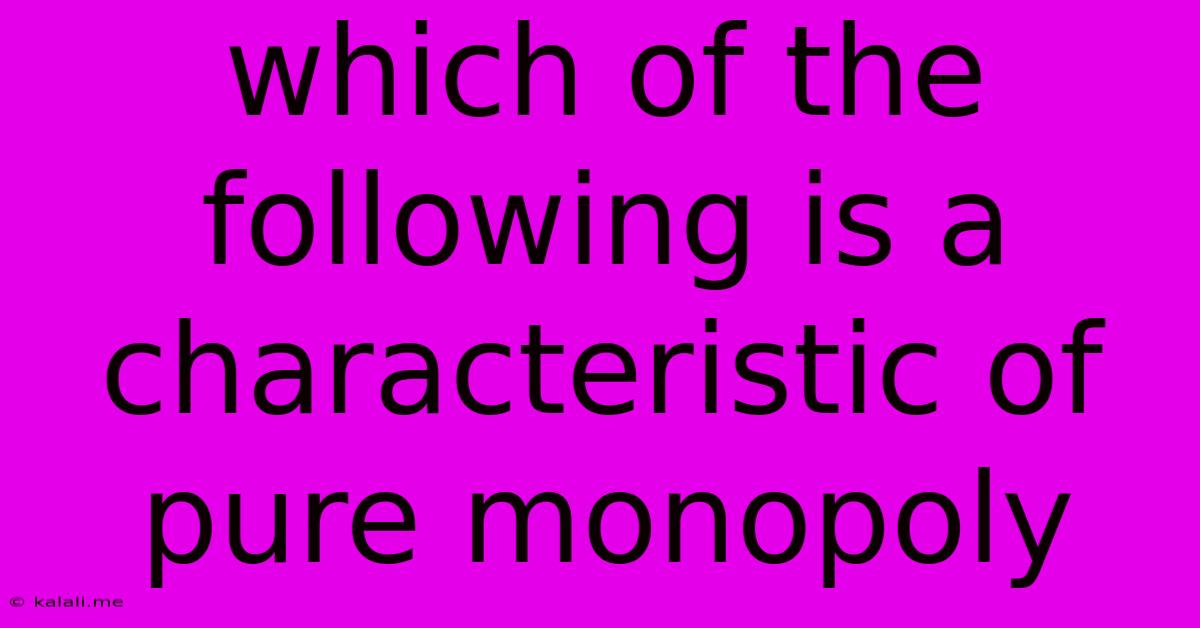Which Of The Following Is A Characteristic Of Pure Monopoly
Kalali
Jun 15, 2025 · 3 min read

Table of Contents
Which of the following is a characteristic of pure monopoly? Understanding the Defining Features
A pure monopoly, in the world of economics, represents a market structure where a single firm controls the entire supply of a particular good or service. This isn't just about having a large market share; it's about possessing complete dominance. Understanding the characteristics of a pure monopoly is crucial for anyone studying economics, business, or market structures. This article will delve into the key features that define a pure monopoly, separating myth from reality.
Key Characteristics of a Pure Monopoly
Several defining characteristics set pure monopolies apart from other market structures like perfect competition, monopolistic competition, and oligopolies. Let's explore the most important ones:
1. Single Seller: The Defining Feature
The most fundamental characteristic is the presence of only one seller in the market. This single firm produces the entire output of a specific good or service. There are no close substitutes readily available. This gives the monopolist complete control over the market supply.
2. Unique Product: No Close Substitutes
The product offered by a pure monopolist is unique. This means there are no readily available substitutes that consumers can easily turn to. While there might be alternative goods or services, they're not considered close enough substitutes to meaningfully constrain the monopolist's pricing power. This uniqueness often stems from patents, copyrights, control of essential resources, or significant economies of scale.
3. High Barriers to Entry: Keeping Competitors Out
One of the most crucial aspects is the presence of extremely high barriers to entry. This means it's incredibly difficult, if not impossible, for new firms to enter the market and compete with the existing monopolist. These barriers can include:
- Legal restrictions: Patents, copyrights, and government licenses can prevent competition.
- Control of essential resources: Owning or controlling vital raw materials or infrastructure can shut out potential competitors.
- High start-up costs: Enormous initial investments needed to establish a business in the industry may deter new entrants.
- Economies of scale: Existing firms might benefit from economies of scale, making it difficult for newcomers to match their efficiency and pricing.
4. Price Maker: Control over Price and Output
Unlike firms in competitive markets that are price takers, a pure monopolist is a price maker. This means they have significant control over both the price and the quantity of the good or service they offer. They can manipulate the price to maximize their profits, though they must consider the demand curve to avoid selling too little or too much.
5. Downward-Sloping Demand Curve: The Price-Quantity Relationship
The demand curve facing a pure monopolist is downward-sloping. This reflects the inverse relationship between price and quantity demanded; to sell more, the monopolist generally needs to lower the price. This contrasts with the perfectly elastic horizontal demand curve faced by firms in perfect competition.
6. Potential for Profit Maximization through Price Discrimination
Monopolists often engage in price discrimination to maximize their profits. This involves charging different prices to different consumers based on their willingness to pay. This strategy aims to extract the maximum possible surplus from the market. Examples include airline tickets or movie pricing.
In Conclusion:
A pure monopoly is defined by a unique combination of factors. Identifying a true pure monopoly is rare in the real world, as most markets exhibit some level of competition. However, understanding these characteristics helps us analyze the behavior of firms with significant market power and the impact they have on consumers and the economy. The characteristics described above provide a crucial framework for recognizing monopolistic tendencies and evaluating their implications.
Latest Posts
Latest Posts
-
First 18 Elements Of Periodic Table
Jun 15, 2025
-
How Many Triangles Are There In This Figure
Jun 15, 2025
-
Aptitude Tests Are Used To Indicate
Jun 15, 2025
-
What Layer Do Meteors Burn Up In
Jun 15, 2025
-
Difference Between An Article And A Journal
Jun 15, 2025
Related Post
Thank you for visiting our website which covers about Which Of The Following Is A Characteristic Of Pure Monopoly . We hope the information provided has been useful to you. Feel free to contact us if you have any questions or need further assistance. See you next time and don't miss to bookmark.